†Corresponding author. E-mail: dxquan@xidian.edu.cn
*Project supported by the National Natural Science Foundation of China (Grant Nos. 61372076 and 61301171), the 111 Project (Grant No. B08038), and the Fundamental Research Funds for the Central Universities, China (Grant No. K5051201021).
In this paper, two novel schemes for deterministic joint remote state preparation (JRSP) of arbitrary single- and two-qubit states are proposed. A set of ingenious four-particle partially entangled states are constructed to serve as the quantum channels. In our schemes, two senders and one receiver are involved. Participants collaborate with each other and perform projective measurements on their own particles under an elaborate measurement basis. Based on their measurement results, the receiver can reestablish the target state by means of appropriate local unitary operations deterministically. Unit success probability can be achieved independent of the channel’s entanglement degree.
Over the past decades, the application of quantum mechanics in the field of computer science and information theory has motivated an emerging research area, quantum computation and quantum information.[1] Encoding information in quantum states provides a totally new method for information processing beyond the capabilities of its classical counterparts. Transferring a quantum state faithfully and securely between remote communicating peers is of greatest significance. One of the most remarkable protocols for states transmission is quantum teleportation, put forward by Bennett et al.[2] in 1993, allowing the teleportation of an unknown quantum state via an Einstein– Podolsky– Rosen (EPR) pair as the quantum channel with the aid of Bell measurement and two bits of classical communication. Later, a new protocol referred to as remote state preparation (RSP)[3– 5] was introduced, in which a known state can be remotely prepared using the same quantum channel as in quantum teleportation but with lower classical communication cost. However, in RSP full knowledge of the to-be-prepared state (generally called the target state) is disclosed to the sender. To overcome this drawback, joint remote state preparation (JRSP)[6, 7] was proposed. It mainly deals with the scenario that the complete set of parameters identifying the target state is shared by two or more senders located in different places who tend to remotely prepare the target state at the receiver’ s site with mutual collaboration.
Due to its significant advantages in quantum states transmission, JRSP has been extensively investigated both theoretically[8– 14] and experimentally.[15, 16] Nevertheless, most of them are accomplished only with success probabilities of less than 100%, that is, they are probabilistic. In recent years, Xiao, [17] An, [18] Bich, [19] Xia, [20] Zhan, [21] and Wang[22] independently put forward a series of deterministic JRSP protocols. As a matter of fact, the above-mentioned deterministic JRSP protocols are realized via maximally entangled quantum channels. Generally speaking, due to the unavoidable interaction between the quantum channel and its surrounding environment, the maximally entangled states may readily evolve into the partially entangled states.[23– 25] Taking this into consideration, very recently, Jiang[26] presented a scheme for deterministic JRSP of general multi-qubit states via a partially entangled Greenberger– Horne– Zeilinger (GHZ)-type channel. However, in their scheme, the unit success probability is generally ensured by recursive channel modulations.
In this paper, we are focusing our attention on the deterministic JRSP of arbitrary single- and two-qubit states with the above-mentioned limitations removed. Considering the technological challenges to prepare and maintain maximal entanglement in real-world implementations, we construct a set of ingenious four-particle partially entangled states to serve as the quantum channels. To accomplish the JRSP tasks, participants cooperate with each other and perform projective measurements on their own particles, combined with the feed-forward technique.[14, 17] Based on their measurement results, the receiver can reestablish the target state by means of appropriate local unitary operations with unit success probability, which is demonstrated by detailed analysis.
The rest of this paper is organized as follows. In Section 2, an ingenious partially entangled quantum channel is constructed. In Section 3, a scheme is proposed for implementing deterministic JRSP of an arbitrary single-qubit state and the corresponding quantum logic circuit is designed, then we extend it to a scheme involving arbitrary two-qubit states in Section 4. Finally, some conclusions are drawn in Section 5.
The four-particle partially entangled state that we characterize throughout this paper can be represented as

To obtain this state, we construct a quantum circuit by using the compositions of Hadamard gates, control-NOT (CNOT) gates and rotation gates, as shown in Fig. 1. H is the Hadamard operation[1]

With the dot “ • ” denoting the control qubit, the CNOT gate takes the form of the following 4 × 4 matrix:[1]

Moreover, the rotation gate Ry(γ ) can be expressed as[1]

where γ indicates the tangle of rotation around the y-axis.
The input of the circuit is a separable state | 0000⟩ 1234, due to the Hadamard operation and the first three CNOTs, a four-qubit GHZ state is obtained

After the subsequent Ry (− γ ), CNOT, and Ry (γ ) operations, | GHZ⟩ four can be transformed to the desired four-particle partially entangled state | QC⟩ 1234, expressed as Eq. (1). This state is characterized by a single parameter γ , whose value is known to the receiver alone. Based on Eq. (1), when γ = 0, 

In this section, we detail our scheme for deterministic JRSP of an arbitrary single-qubit state. Suppose that two independent senders, Alice and Bob, located at two spatially separated places, intend to help a remote receiver Charlie prepare an arbitrary single-qubit state taking the general form

where | 0⟩ and | 1⟩ are two eigenstates of a single-qubit, the real coefficients a0, a1 ≥ 0, and θ ∈ [0, 2π ] with the normalization condition 
To achieve the task of JRSP, Alice, Bob, and Charlie initially share the following partially entangled quantum channel:

Subscripts indicate that particle A belongs to Alice, Bob is in possession of particle B, and Charlie owns particles C1 and C2. Generally, Charlie is responsible for the preparation of the quantum channel | QC⟩ ABC1C2, subsequently he will distribute particles A and B to Alice and Bob, respectively, with particles C1 and C2 reserved in his local site.
In order to help Charlie prepare the target state | χ ⟩ 1, as shown in Fig. 2, firstly, Alice performs a projective measurement on her particle A (PMA). Based on her knowledge of the target state, Alice chooses a set of measurement basis:

where the superscript “ s” indicates the scenario involving single-qubit states.
According to the measurement postulate of quantum mechanics, the shared quantum channel | Q⟩ 1 can be rewritten in terms of Alice’ s measurement basis as
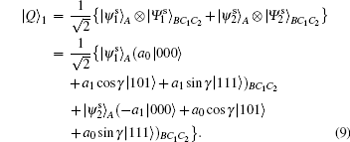
From Eq. (9) it is easily verified that Alice’ s PMA will project the joint state of particles B, C1, C2 onto one of the two possible states 

| Table 1. Corresponding relations between Alice’ s PMA result and Bob’ s unitary operation. Here I is the identity operator and σ x is Pauli-X operator. |
Without loss of generality, here we consider the case that the result of Alice’ s PMA is 

Above operations can be expressed analytically as follows:

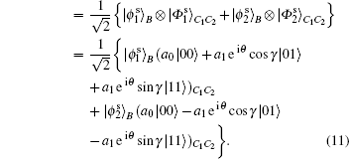
From Eq. (11) it is transparent that after Bob’ s projective measurement PMB, with an equal probability 

| Table 2. Charlie’ s recovery operator UC conditioned on Alice’ s RA, Bob’ s RB, and Charlie’ s RC, where I is the identity operator and σ x, iσ y, and σ z are Pauli matrices. The probabilities (or conditional probabilities) associated with various measurement results are also listed. |
As an example, we might as well consider the situation that the result of Bob’ s PMB is 

From Eq. (12), it is apparent that after Charlie’ s PMC, the state of particle C2 is perfectly correlated to the target state | χ ⟩ 1. In our discussion here, Alice’ s PMA and Bob’ s PMB results are 

As a supplement, when it comes to the other case corresponding to Alice’ s PMA result 

We now turn our attention to discuss the deterministic JRSP of an arbitrary two-qubit pure state. Following the basic idea in Section 3, suppose that two distantly separated senders, Alice and Bob, intend to help the receiver Charlie remotely prepare an arbitrary two-qubit state, which reads

where the real coefficients bi ≥ 0 (i = 0, 1, 2, 3) and θ j ∈ [0, 2π ], (j = 1, 2, 3) with the normalization condition 
To accomplish the task of JRSP, the senders Alice, Bob, and the receiver Charlie previously share the quantum channel consisting of two four-particle partially entangled states given by

Among these eight particles, particles A1 and A2 belong to Alice, Bob is in possession of particles B1 and B2, and Charlie owns particles C1, C2 and C3, C4. Consistent with the basic idea in Section 3, Charlie is responsible for the preparation of the quantum channel | QC⟩ A1B1C1C3 ⊗ | QC⟩ A2B2C2C4, subsequently he will distribute particles A1, A2 to Alice, and B1, B2 to Bob, with particles C1, C2 and C3, C4 reserved by himself.
As is shown in Fig. 3, for the purpose of achieving the JRSP task, firstly, Alice carries out joint projective measurement on her particles A1 and A2 (PMA) by choosing a set of complete orthonormal basis {| ψ 1⟩ , | ψ 2⟩ , | ψ 3⟩ , | ψ 4⟩ } conditioned on her knowledge of the target state | χ ⟩ 2, which reads

According to the measurement postulate of quantum mechanics, the whole quantum system consisting of eight particles can be expressed in terms of Alice’ s measurement basis as
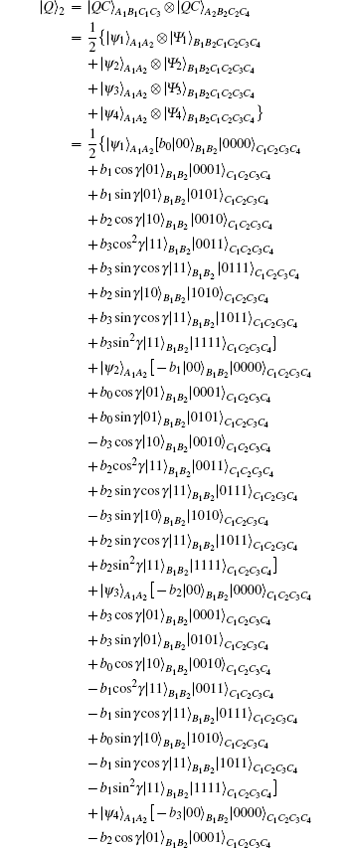
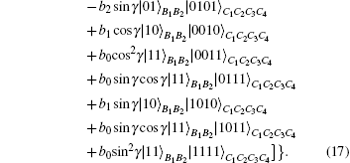
Alice’ s projective measurement PMA will project the joint state of particles B1, B2, C1, C2, C3, C4 onto one of the four possible states {| Ψ 1⟩ , | Ψ 2⟩ , | Ψ 3⟩ , | Ψ 4⟩ }B1B2C1C2C3C4 with an equal probability of PRA = 1/4, as shown in Eq. (17). After her projective measurement, Alice broadcasts her result to Bob and Charlie. Conditioned on the received PMA result, Bob selects suitable unitary operations (UB) to perform on his particles B1 and B2. Various situations involving Alice’ s PMA results and Bob’ s unitary operations are listed out in Table 3.
| Table 3. Corresponding relations between Alice’ s PMA result and Bob’ s unitary operation. |
Without loss of generality, here we consider the case that Alice’ s PMA result is | ψ 2⟩ A1A2. At this point, Bob will carry out the unitary operation UB = I ⊗ σ x on his particles B1 and B2, and subsequently, on the same particles, he performs projective measurement (PMB) with the following complete orthonormal basis:

Above operations can be expressed analytically as follows,
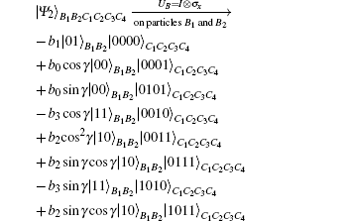
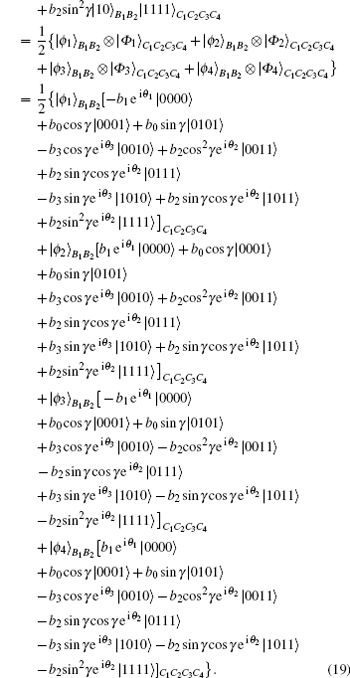
From Eq. (19) it is obvious that after the projective measurement PMB, with an equal probability PRB| RA = 1/4, Bob will obtain one of the possible states {| ϕ 1⟩ , | ϕ 2⟩ , | ϕ 3⟩ , | ϕ 4⟩ }B1B2 which he needs to inform Charlie with the aid of classical communication. Upon receiving Bob’ s message, Charlie applies Ry (− γ ) ⊗ Ry (− γ ) on his particles C1 and C2, followed by a projective measurement on the same particles (PMC) under the basis {| 00⟩ , | 01⟩ , | 10⟩ , | 11⟩ }. Finally, depending on Alice’ s, Bob’ s and his own measurement results, Charlie’ s job is simply to perform an appropriate unitary operation (UC) on particles C3 and C4 to recover the target state | χ ⟩ 2. Various situations are listed out in Table 4.
| Table 4. Charlie’ s recovery unitary operator UC conditioned on Alice’ s RA, Bob’ s RB, and Charlie’ s RC, where I is the identity operator and σ x, iσ y, σ z are Pauli matrices. |
As an example, we might as well consider the situation that the result of Bob’ s PMB is | ϕ 2⟩ B1B2, then based on Eq. (19), the state of particles C1, C2, C3, and C4 evolves as
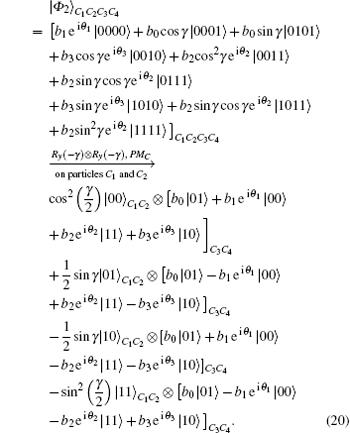
Note that after Charlie’ s PMC, the state of particles C3 and C4 in Eq. (20) is perfectly correlated to the target state | χ ⟩ 2. According to Alice’ s, Bob’ s and his own measurement results, Charlie can recover the target state | χ ⟩ 2 by appropriate local unitary operations. In our discussion here, Alice’ s and Bob’ s measurement results are | ψ 2⟩ A1A2 | ϕ 2⟩ B1B2, if Charlie’ s measurement result is | 00⟩ C1C2 with the probability of PRC| RARB = cos4(γ /2), then UC = I ⊗ σ x is required to perform on particles C3 and C4, the target state | χ ⟩ 2 can be readily reestablished, as shown in Table 4.
As a supplement, when it comes to the other three cases corresponding to Alice’ s projective measurement results | ψ 1⟩ A1A2, | ψ 3⟩ A1A2 and | ψ 4⟩ A1A2, there will be a similar analysis process. Here we no longer depict them one by one. According to Table 4, it is easily found that, for all the possible measurement results of Alice, Bob, and Charlie, the receiver Charlie is always able to reconstruct the target state | χ ⟩ 2 by performing appropriate unitary operation UC on particles C3 and C4. Thus, our JRSP scheme is deterministic. Mathematically, the total success probability reads

In summary, by constructing a set of ingenious four-particle partially entangled states to serve as the quantum channels, we have investigated deterministic JRSP of arbitrary single- and two-qubit states. Correspondingly, the quantum circuits for our JRSP schemes are designed. In this article, we deal with the JRSP from two senders to one receiver. Participants collaborate with each other, and perform projective measurements under an elaborate measurement basis on their own particles. Combined with the feed-forward technique adapted by senders, that is, before performing his projective measurement PMB, Bob should perform a suitable unitary operation on his particles conditioned on the result of Alice’ s PMA. This way, the receiver can reestablish the target state by means of appropriate local unitary operations with unit success probability. Furthermore, based on our research here, an extension to deterministic JRSP of general multi-qubit states is possible.
It needs emphasizing that, at variance with most existing JRSP protocols, in our schemes, the receiver plays quite an active role in the sense that he not merely performs the reconstruction operation at the end, his projective measurement result is equally useful as that of both senders. In addition, to accomplish the JRSP tasks, the initially shared partially entangled quantum channels are necessary, but unit success probability can always be achieved irrespective of the channel’ s entanglement degree. This point is very interesting and primarily meaningful considering the technological challenges to prepare and maintain maximal entanglement in real-word implementations.
Regretfully, there is a limitation lying in this paper. The achievement of the JRSP depends critically on the receiver’ s knowledge of the quantum channel, requiring the channel parameter γ to be constant during the JRSP procedure. After completing the preparation of the quantum channel, particles should be distributed to corresponding participants. During the distribution process, not simply the parameter γ but the quantum channel as a whole will be changed due to the unavoidable “ en route” decoherence. In fact, this is a limitation for almost all the existing JRSP protocols. To overcome this limitation, there is still a lot of work to do.
| 1 |
|
| 2 |
|
| 3 |
|
| 4 |
|
| 5 |
|
| 6 |
|
| 7 |
|
| 8 |
|
| 9 |
|
| 10 |
|
| 11 |
|
| 12 |
|
| 13 |
|
| 14 |
|
| 15 |
|
| 16 |
|
| 17 |
|
| 18 |
|
| 19 |
|
| 20 |
|
| 21 |
|
| 22 |
|
| 23 |
|
| 24 |
|
| 25 |
|
| 26 |
|
| 27 |
|
















